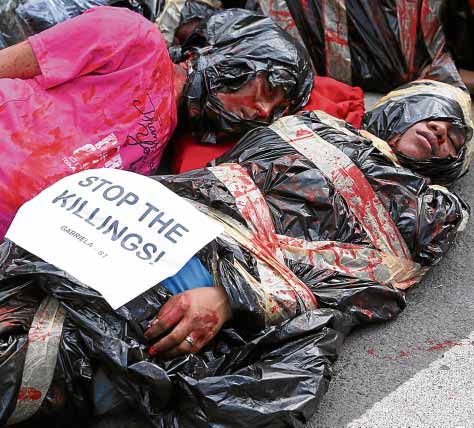‘Tokhang’ data: Slain suspects carried mostly .38-caliber guns

On Human Rights Day last Dec. 10, activists dramatize victims of summary killings that they blame on the war on drugs being waged by the Duterte administration. —MARIANNE BERMUDEZ
Most of the “Oplan Tokhang” cases involving suspects killed by the police for “fighting back” (“nanlaban”) were men aged 21 to 40, supposedly carrying a few sachets of “shabu” (crystal meth) and wielding a .38-caliber gun, according to spot reports submitted by the Philippine National Police.
The operations took place mostly between midnight and 5:59 a.m., as well as between 6 p.m. and 11:59 p.m., the police data showed.
Not surprisingly, the bulk of the incidents were reported in July 2016 when President Rodrigo Duterte assumed office, according to data submitted by the PNP to the House public order committee.
1,005 spot reports
The PNP submitted at least 1,005 spot reports involving 1,671 individuals killed in antidrug operations from July 2016 to September 2017 around the country.
Article continues after this advertisementThe data were compiled and collated by Magdalo Rep. Gary Alejano, who presented to media some of his findings.
Article continues after this advertisementAccording to the PNP, the number of deaths related to antidrug operations had ballooned to 3,850 in September 2017.
But the spot reports submitted by the PNP to the House panel constituted only about a quarter, or 26 percent, of the total.
Pattern
“The data we received may not be conclusive since we still lack a majority of the data, yet we could draw some pattern or information from the reports that were submitted from our office,” Alejano said.
The bulk of the reports was prepared in July 2016, the first month of the Duterte administration.
“We can observe that the frequency of the reports has greatly declined after the initial month of the PNP’s implementation of their anti-illegal drugs campaign,” said Alejano.
“The decline may have been influenced by the drop in President Duterte’s trust rating during the said period due to the public’s reaction on the conduct of the PNP’s operation against the drug menace,” he said.
He added that “the decline may have been a result of a shift from official police operations to vigilante killings.”
“These resulted in deaths of suspects, a bulk of which remain unresolved. The shift eased the pressure on the PNP from the public,” he said.
Unsolved killings
More than 80 percent of the individuals mentioned in the numerous spot reports were male.
Most of the slain suspects have unspecified ages, while individuals with ages 21 to 40 came in second.
Most of the weapons (37.1 percent) confiscated during these operations from the slain suspects were .38-caliber firearms.
“This could be because [the] said weapon is cheaper, more accessible to individuals due to proliferation of ‘paltik,’” said Alejano. “However, it is very important to note that most of the weapons recovered as per the spot report of the PNP have unspecified or altered serial numbers.”
“This could give an impression that the same weapons are being used as ‘tanim ebidensya’ (planting of evidence) in these operations over and over again,” he said.
Of the 1,671 slain suspects, 86.6 percent were accused of using or peddling shabu, consistent with the government’s claim that it remains to be heavily traded in the Philippines.